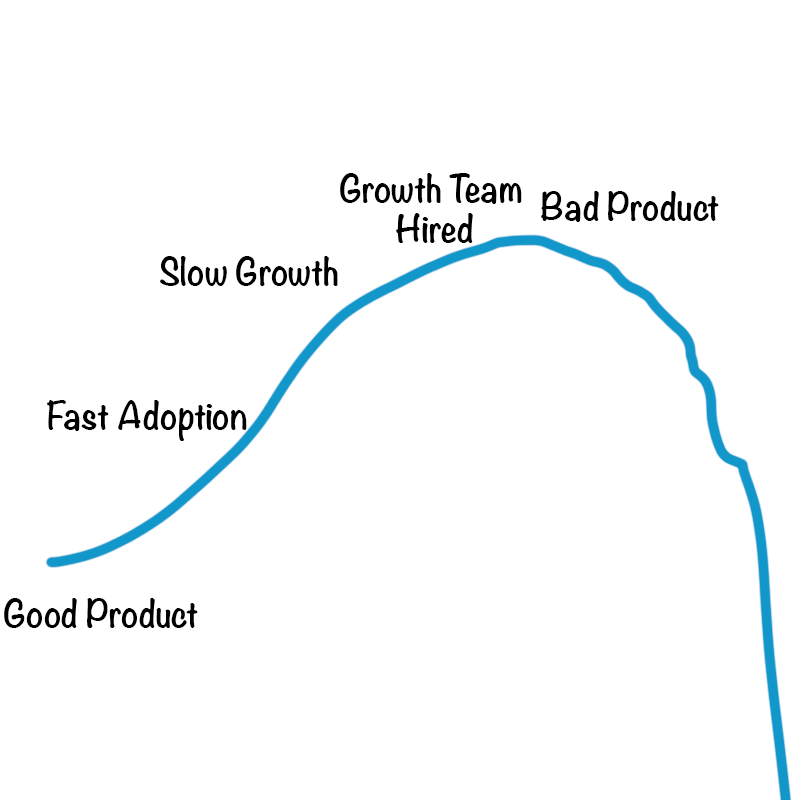The Trouble with Growth
Pedram's Universal Theory of Bad Outcomes
Do you remember a time when products were good? Unblemished by all the things which make them bad? I do. It happens, from time to time. A product is released, and people enjoy it. It provides a service; users adopt it because it is good and enjoyable. But that is never enough. The markets demand more. Scaling out horizontally and building additional product-lines that people want is hard work. What if we added new buttons instead?
Remember Zoom? A pleasant way to run virtual meetings. A clean interface, good video and audio quality, and an easy way to create, schedule, and share meetings. But was that enough? No.
Instead, there are Limited Time Offers and Apps for things no one has ever heard of, like twine (advanced breakouts), or Sesh (a virtual agenda) or W (AI Business Cards). I have no opinion on the usefulness of advanced breakouts or AI Business Cards. Still, I do know that seeing these pop-up in my Zoom meetings automatically, unwarranted is not something I would ever want.
I’m not alone; there are dozens of us out there. And this isn’t strictly a Zoom phenomenon. It happens everywhere, and it’s so pervasive I would argue it’s a driving force for many new products. Old products get so bad that people leave in frustration for anything that stops treating them so poorly.
Remember Gmail? This is what it looks like today.
There’s Mail, Chat, Spaces, Meet on one sidebar. A whole different sidebar on the right for Google Calendar, Keep, Tasks, and Contacts. Not to mention Active? Whatever that is. Gmail became so annoying that people started paying for an email client to avoid having to login to that nightmare.
Microsoft Windows 11 is so bad that entire websites are dedicated to helping people remove advertisements from your operating system. Only Adobe could perhaps rival Microsoft in this domain. Something as simple as saving a file is now a complex feature-parity contest.
It’s a clear and pervasive trend, but the question is why is it happening and why is Pedram writing about this in a data newsletter? Is he going to try and weave some tangental thread through these as if there’s some type of natural connection with his central thesis, and pretend that this isn’t just an excuse to complain about things that annoy him?
Absolutely not.
Simpson’s Paradox, Local Maximums and Other Tangential Threads
In statistics, Simpson’s paradox is a confusing trend where what appears to be a correlation in one direction may actually be a trend in another direction. What the model failed to do was account for confounding variables. What appeared to be a positive trend may actually have been a negative trend for each subgroup.

Somewhat related is Anscombe’s famous Quartet of identical datasets when explored using summary statistics, but with obviously different distributions. On the surface, looking at a high-level summary, the data all looks the same, but when plotted, or analyzed more carefully, it turns out there are four very different models at work.
There’s also the oft-used (and abused) idea of local maxima, where what seems like the best decision given the current context is far behind the globally best decision given full context. It’s a common pushback against experimentation-culture, where the critics say that small incremental changes are unlikely to lead to the large, big-bet changes that help build lasting companies.
These are well-understood entry-level concepts within statistics. But they all point to a common trend I think we see in some of the products I described above and many others.
What starts as a good product, gains adoption. The fast pace of growth eventually slows due to the laws of physics. Rather than update models and assumptions, the company hires a growth team; they ‘experiment’ and each experiment in isolation seems like a good idea. They might move the metrics in the right direction. Maybe they generate marginal increases in revenue. But the overall experience suffers. And soon, all these marginal improvements end up creating a bad product, which inevitably leads to the downfall. New players sense this weakness and dissatisfaction, and competition enters the field to serve your market better than you did.
This same model plays out in the data ecosystem. Vendors who build something really good at first can quickly find that they’ve tapped their initial market. Faced with this precipice, they look for ‘quick wins’. But quick wins is code for minor optimizations.
What they should have been doing was preparing for this scenario months ago. The best founders are always paranoid and never satisfied. They’re less focused on how to win today, but on what to win next.
As you’re building out products and gaining success, I’d encourage founders to ask themselves that same question. You have an entire team dedicated to helping you win today. The question you should be always asking yourself is what’s next?












I blame Netflix and them moving away from stars to thumbs. Beginning of the end for me.
Moving into product management now, eh? Yeah I agree with everything you said. Great post